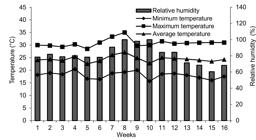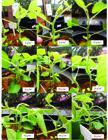ABSTRACT:
The hormesis effect of 2,4-D, applied at two stages of soybean development, on the physiological components of crop yield, was investigated. Soybean seeds of the cultivar ‘AG 3680 IPRO’ were sown in pots containing 7 L of a substrate and kept in a greenhouse. A randomized complete block design with four replicates was used. Eighteen treatments were tested, arranged in a split-plot scheme. The plots consisted of two stages of herbicide application (V4 and V6), and the split-plots were arranged by nine 2,4-D doses (0, 5, 10, 15, 20, 25, 30, 40, and 50 g ha-1). At the time of harvest, 100 days after sowing, significant interactions between crop development stages and 2,4-D doses were observed for the number of nodes in the main stem (NNMS) and the number of pods per plant (NPP). Both NNMS and NPP were not affected by 2,4-D during V6, but they increased with doses up to 20.2 g ha-1 and 22.5 g ha-1, respectively, during V4 and declined at higher doses according to a quadratic model, thus characterizing hermetic effect. Regardless of the application stage, the number of grains per plant and weight of a thousand grains were reduced as doses increased. However, the grain number and grain mass per plant reached maximum values for doses of 20.3 g ha-1 and 12.9 g ha-1, respectively. It was concluded that 2,4-D causes hormesis effects on the soybean crop ‘AG 3680 IPRO’ pot-grown in greenhouse conditions, regardless of the application stages herein tested.
Keywords:
Glycine max; auxin; herbicide

 Thumbnail
Thumbnail
 Thumbnail
Thumbnail
 Thumbnail
Thumbnail


 *, **: Significant at 5% and 1% of probability, respectively, by the t-test. ns: not significant. The dispersion refers to the mean standard deviation of the average (n= 4 orn= 8).
*, **: Significant at 5% and 1% of probability, respectively, by the t-test. ns: not significant. The dispersion refers to the mean standard deviation of the average (n= 4 orn= 8).